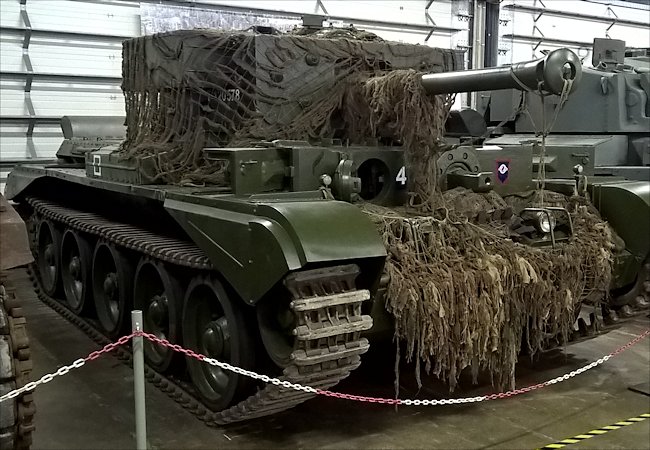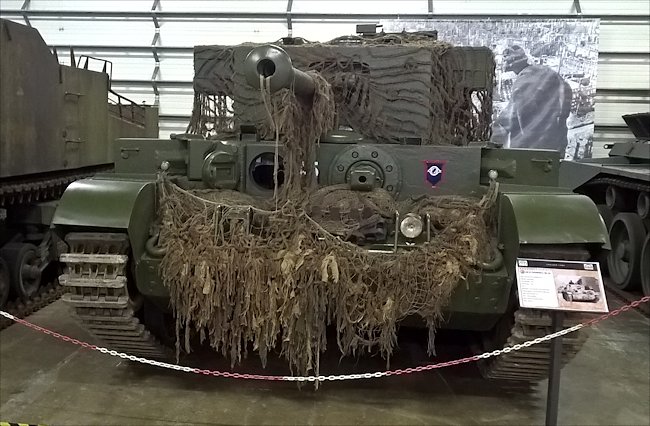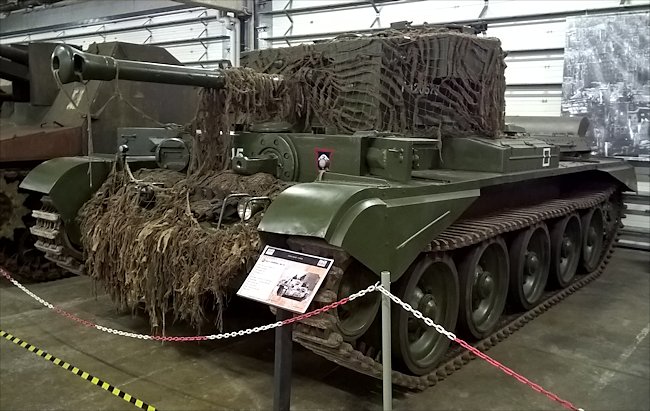British A27M Cromwell Tank Mk VII
British A27M Cromwell Tanks did see action in the WW2 Battle of the Bulge with the British 11th Armoured Division. This surviving A27M Cromwell Tank is kept at the Bastogne Barracks in Belgium..

This restored British A27M Cromwell Tank Mk VII is exhibited at the Bastogne Barracks in Belgium.
Location
The Bastogne Barracks can be found at 40 Rue de la Roche (N834) in Bastogne just north west of the city centre. They open at 10am and close at 4pm. You really need to get there by 2pm as there is a lot to see. It is an operational military camp with a tank restoration centre attached. You have to wait to go on a guided tour. You cannot wander around on your own. The only day it is closed is Monday. Many of the tanks have been restored to running condition. Have a look at their Facebook page for information about new events.

This preserved British A27M Cromwell Tank Mk VII is exhibited at the Bastogne Barracks in Belgium.
Yes the British Army did fight at the Battle of the Bulge
If you believe Hollywood the British Army took no part in the battle of the Bulge. The American Army one the war all on their own. At the beginning of December 1944 units of the British 11th Armoured Division were put on reserve duties around Ypres while their tank crews started to refit with the new Comet tanks. When the German Ardennes offensive started, (the Battle of the Bulge) being one of few formations in reserve, the 11th Armoured Division was rushed back into to active service with its old, Sherman, Cromwell and Churchill tanks.
They were directed to hold a defensive line along the Meuse, between Namur and Givet. On Christmas Eve its advanced positions spotted and destroyed several tanks of the 2nd Panzer Division, east of Dinant. From 26 December onwards, the Germans started to withdraw and 11th Armoured was replaced by the 7th Airborne Division, after having pushed the enemy back beyond Celles.

This Surviving British A27M Cromwell Tank Mk VII can be found at the Bastogne Barracks in Belgium.
Development of the Cromwell Tank
Initially known as Cromwell Ill, the Meteor-engined version of the A27 design was designated A27M (M = Meteor engine). The Meteor engine as adapted from the Merlin for tank use had about 80% of its component parts identical to the aircraft engine, thus greatly facilitating production for tanks. Rolls-Royce converted a batch of Merlins for use in tanks, and during 1941 two Crusader tanks had Meteor engines installed in place of their Liberty power plants for exhaustive test running.
This enabled positioning of auxiliary components, wear and tear, oil consumption, and so on to be determined at an early date while design work on the A27 itself proceeded. Birmingham Carriage and Wagon delivered the first mild steel prototype to the Army for trials on March 1, 1942, actually ahead of the Centaur pilot model.
Two more pilot models were delivered by the end of 1942, and teething troubles on tests proved relatively minor—mainly detail points concerned with clutch, gears, and cooling. The idea of using the powerful Meteor engine was handsomely vindicated by results, and ample power was available for any forseen developments of the A27 type. Cromwell production started in January 1943, by which time Leyland had become the design and production 'parents' for the entire A27 series. This embraced all subcontractors for component parts as well as plants building Cromwells.
Meanwhile, War Office policy with regards to tank armament had changed considerably since the 'heavy Cruiser' requirement resulting in the A24/A27 series had been formulated. Fighting in the Western Desert, coupled by the decisive appearance of the American-built M3 and M4 Medium tanks in that theatre led to a requirement for a gun with 'dual-purpose' capability—able to fire HE or AP shot—as fitted in the very successful M3 and M4 mediums. Work on a British Designed version of the 75mm gun virtually a bored-out development of the British 6pdr able to fire American ammunition, was put in hand in December 1942 and Cromwells from Mk IV onward were produced with this weapon in place of the 6pdr.
The first vehicles so equipped were delivered in November 1943, but there were many initial defects in this gun, including unsatisfactory semi-automatic cams in the breech, which were not entirely put right until May 1944. The Cromwell was numerically the most important British-built cruiser tank of World War Il, forming the main equipment of British armoured divisions in 1944-45 together with the American-built M4 Sherman. However, even with a 75mm gun it was still, by 1944 standards, inferior to contemporary German tanks like the Panther and late-model PzKw IVs.
With its Meteor engine it was the fastest and most powerful of British tank designs until that period, but physical limitations (mainly the narrowness of the hull) prevented its being upgunned further and considerable redesign was necessary to turn it into a vehicle capable of carrying the very desirable 17pdr gun armament.
All the A24/A27 series were structurally similar, with a hull and turret of simple box shape and composite construction—an inner skin with an outer layer of armour bolted on. Driver and co-driver/hull machine gunner sat in the forward compartment, and the turret crew consisted of the commander, gunner and loader who was also the radio operator. Tracks were manganese with centre guides, and the engine and transmission were at the rear. Numerous detail modifications were incorporated during the Cromwell's production run, which ended in 1945. These are noted below. Most important innovation was the introduction of all-welded construction in place of rivetting on later models, thus further simplifying mass-production.
Cromwell Tank Varients
Cromwell I: Original production model with 6pdr gun. Similar in external appearance to Centaur I.
Cromwell II: Mk I modified by removal of hull machine gun and fitting of wider tracks — 15.5 inch in place of 14 inch.
Cromwell III: Centaur I re-engined with Meteor engine to bring it to A27M standards. Originally designated Cromwell X.
Cromwell IV: Centaur III with 75mm gun re-engined with Meteor engine.
Cromwell IVw: As Mk IV but with all-welded hull, and built with Meteor engine.
Cromwell V w: As Mk IV but with all-welded hull.
Cromwell VI: As Mk IV but with 95mm howitzer replacing the 6pdr for the close support role.
Cromwell VII: Cromwell IV re-worked with applique armour welded on hull front, 15.5 inch tracks replacing 14 inch tracks, stronger suspension, and reduced final drive ratio to govern down maximum speed to 32mph.
Cromwell VIIw: Cromwell Vw modified as above.
Cromwell VIII: Cromwell VI modified as above.
Cromwell ARV: Vehicle with turret removed, winch fitted in turret space, and demountable A-frame jib. Appearance as Centaur ARV (qv).
Cromwell Command/OP: Mk IV, VI or Vlll fitted dummy gun and extra radio equipment for use of formation commander or artillery observation officers.
Cromwell CIRD: Vehicle with fittings to take Canadian Indestructible Roller Device (CIRD) mine exploding equipment. Few only converted.
Cromwell Prong: Standard vehicle fitted with Cullin Hedgerow Cutting Device, Normandy 1944. This equipment, at first, extemporised in the field, then manufactured in limited quantities, was fitted to some Cromwell and Sherman tanks in June-August 1944 to assist in breaking through the extensive hedges and foliage of the ocage country of Normandy which otherwise tended to restrict movement to the roads.
Read more in these two tank books

